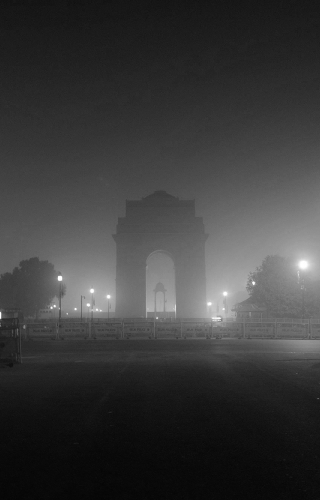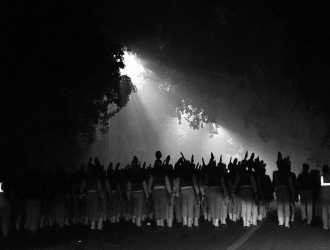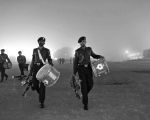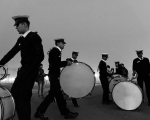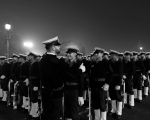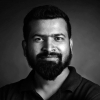I shifted to New Delhi for study and work from a small town in North Bengal. India’s capital instantly made an impression on me, especially events like the Republic Day Parade (RDP) which takes place every year on Januray 26, to mark India’s transition to a Republic and adoption of the Constitution. It is undoubtedly the most important event in the political and military calendar, and also an occasion to display India’s rising power and prestige to the world. I had grown up listening to RDP broadcast on All India Radio and watching it on Doordarshan, but after I shifted to New Delhi, I made every effort to watch it live on Rajpath. My involvement started long before the main event. I turned up to catch the rehearsals, which start in December, culminating in a full dress rehearsal two days before the main event. I would shoot for a couple of hours, from 5 am to 7 am, and then head to office in the darkness of the cold winter morning.
During the rehearsals, I noticed that although the RDP is primarily a visual spectacle, music plays an important role in the event. I was specially struck by military bands, who not only serve the key role of raising the troop morale and instilling patriotic fervour in the audience but also provide rhythmic beat which help maintain synchronity during the march. The bands have the added responsibility to follow musical notations while marching. Even the Border Security Force, who are always a colourful highlight of the RDP, have their own camel-mounted band. Raised from the Bikaner Camel Corps, these band members are specially trained in playing an orchestra while astride a camel!
Blowing trumpets and beating drums had been a long-established tradition in armies of the princely states of the past, but specially trained military bands were introduced by the British Indian Army, modelled on the Royal Military School of Music (RMSM) based at Kneller Hall, West London. Post Independence, there was need to Indianise these bands and play more Indian military music, for which purpose the Army Education Corps (AEC) established the Military Music Wing (MMW) on October 23, 1950, under the patronage and supervision of Field Marshal K.M. Cariappa, the first Indian Commander-in-Chief of the Indian Army. Both the AEC and MMW are based at Panchmarhi, Madhya Pradesh.
MMW’s task is to train bandmasters, music instructors and musicians to perform for paramilitary forces and the three services of the Indian Armed Forces (Army, Navy and Air Force). Each of the services have their respective zonal bands, regimental bands and academy bands. Selection is made on aptitude to play at least one musical instrument and a natural musical inclination. Though band songs are Indianised, old traditions from the British raj days still continue, evident in the use of Western musical instruments. For new recruits, who are mostly unfamiliar with such instruments, training involves learning how to play new instruments and reading Western musical notations.
Though trained as musicians, each band member is first and foremost a military personnel (they serve as medical assistants or evacuation of troops). The best among them get selected to play in the prestigious Indian Army Chief’s Band, which participates in the RDP, but do not march. Instead they sit close to the President of India and the viewing enclosure for chief guests, and are entrusted to play the national anthem just after the President’s Bodyguard do the honor of giving national salute to the President, accompanied by the firing of 21-gun salute and unfurling of the national flag.
Military bands have been part of the RDP since the first parade in 1950. Bands are not restricted only to military and paramilitary contingents but also include school groups, boy scouts and Delhi Police bands. The National Cadet Corps have their own band, so does Birla Balika Vidyapeeth, from Pilani, Rajasthan, which have participated as a band every year since the inception of RDP in 1950. The bands assemble in the cold pre-dawn hours and rehearse their march with equal discipline as the regimental troops. In addition, they synchronise their orchestra, which belts out crowd favorite songs like ‘Saare Jahan se Achha’, ‘Vijay Bharat’ and ‘Kadam Kadam Baraye Jaa’, among many others.
Post Independence there has been an effort to expand the song list. Military bands now include compositions taken from Hindi films. In the 2020 RDP, songs were played from movies like Lakshyaand ‘Ae Mere Pyaare Watan’from Kabuliwala. Songs by foreign composers have been phased out, and more Indian composers are featured, mostly from within the armed forces. In the 2020 RDP, out of 26, only one foreign origin song was played—‘Abide by me’, written by Scottish poet Henry Francis Lyte and composed by William Henry Monk. Traditionally this song is the last song played before lowering of the national flag and has been part of Beating Retreat ceremony since 1950.
Republic Day festivities end with the Beating Retreat, which takes place on January 29, when all the bands put up a combined performance in front of the President of India at Vijay Chowk. The drummers give a solo performance, known as Drummer's Call. This is followed by a bugle call for sunset, when the national flag is lowered. The band master then marches to the President and requests permission to take the bands away, and informs that the closing ceremony is now complete. Surprisingly, though a British concept, Beating Retreat was not originally part of the RDP, but was added during a visit by Queen Elizabeth II of England and her consort, Prince Phillip, who were chief guests for the event. It is also interesting to note that the RDP didn’t start at Rajpath, but shifted here only in 1955, and it has been the permanent venue ever since. Such innovations in the RDP are important landmarks and show how the event has changed over the years.
Even now, every year some new tradition is established. For example, in 2019, the Prime Minister, the Defence Minister and the three service chiefs (plus Chief of Defence Staff) paid tribute to the Immortal Soldier (Amar Jawan Jyoti) at the newly built National War Memorial. Buglers at this solemn event sound the Last Post call; the first music of any kind played at the RDP. This event used to earlier happen at India Gate, which was built as a memorial to honor 70,000 Indian troops who died in World War I and other campaigns of the British Indian Army from 1914 to 1921.
Even during rehearsals, regiments demonstrate high standards of discipline and coordination, which is a result of rigorous and continuous training spread over months and years. The RDP rehearsals are highly competitive, not only because it is seen by millions of Indians live but also because there is an award to be won for the best marching contingent, both for the armed forces and the paramilitary forces. This prize brings great honor to the regiment and is much sought after. On the day of the parade, everything comes together perfectly in a tightly choreographed event, which is completed within two hours and half hours.
I have been working on this photo story for the last four years, but I have only now started to get an idea of the immense effort participants put in each year. In the future I intend to document the personal stories of the soldiers, their regiments, the endless hours of practice, and every detail that goes in the making of the RDP. If anyone wants to get an early feel of the RDP, a good staring point is to attend the rehearsals first. Another wonderful opportunity is attending the Beating Retreat ceremony. For experiencing these events, tickets are available from early January from counters at the North Block Roundabout, Shastri Bhawan, Sena Bhawan, Pragati Maidan, Jantar Mantar, Red Fort, etc. However, they still sell out very quickly after the ticket counters open at 10 am, so it is recommended that one line up as early as 8 am.
